Hawk Identification Guide: Easy Tips And Photos
Hawks are majestic creatures with several unique characteristics along with their role as top predators in the avian world. Also, hawks have unimaginable sharp eyesight, impressive flying abilities, top-notch fighting capabilities, etc. Certainly, their size, shape, and plumage also attract human beings.
Along with all these amazing features, hawks also significantly contribute to the ecosystem of the planet Earth. This context demands our concern to know as much as possible about this bird. Here, we would like to inform you that the hawk identification process can be difficult as there are several species in this category.
Identification of each one assists us in imposing appropriate efforts to save their population and maintain environmental sustainability. So, let’s get to know about them in more depth.
What are the Fundamental Aspects of Hawk Identification?
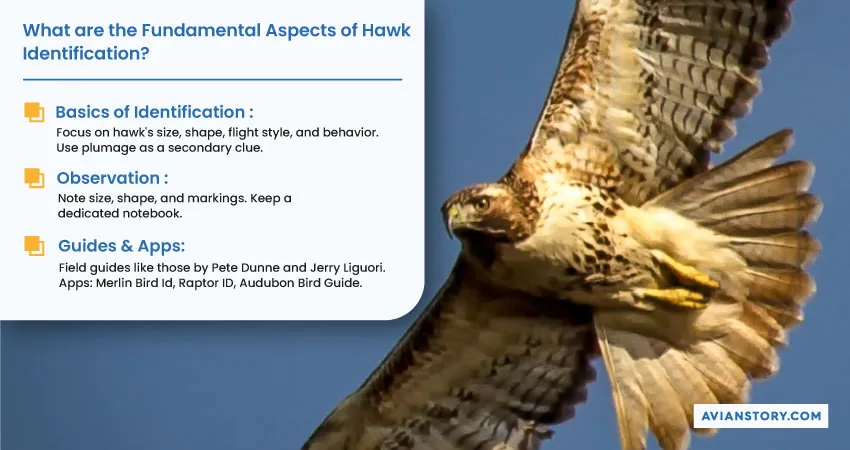
Our expert observation says there are three fundamental aspects of hawk identification. They are; understanding the basics of bird identification, emphasizing careful observation and utilizing field guides and identification apps. Let’s discuss them one by one.
Basics of Bird Identification
This is the first aspect of the hawk identification process. To embrace this, you must acquire a solid knowledge base about the general characteristics of different hawk species. In this case, you have to know at least their size, shape, flight style, behavior, etc.
You will face difficulties in the beginning if you take each hawk species’ plumage as the baseline of the identification. So, put plumage as a secondary consideration.
Perform Careful Observation
After knowing the basics, go for close observation. Pay attention to various features of the bird, including its size, shape, coloration, and distinctive markings. We strongly recommend you use a notebook to write down important findings for each type of hawk.
Use of Field Guide and Identification App
Field guides are books or online references that provide detailed information, illustrations, and photographs of bird species, including hawks.
Some must-mention field guides for hawk identification are
- Hawks in Flight by Pete Dunne
- Hawks at a Distance by Jerry Liguori.
- Hawks from Every Angle: How to Identify Raptors In Flight by Jerry Liguori.
You can use these learning items to use your findings to identify hawk species. Also, you can use any reputed bird identification app to minimize basic learning. Some must-mention apps are listed below:
- Merlin Bird Id: Free, Android
- Raptor ID: Compatible with iPad
- Audubon Bird Guide: Free, Android & iOS
How Do Hawks Differ in Physical Appearance?
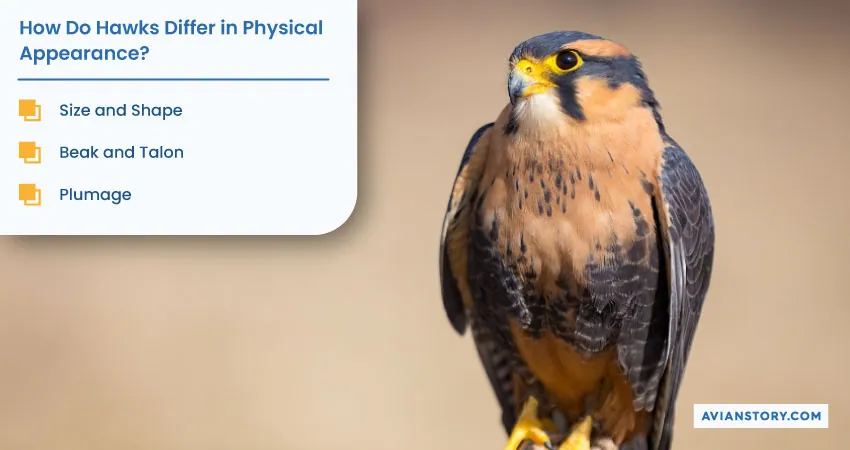
In consideration of physical appearance, we find three core differential contexts. Below are the details.
Size and Shape
Hawks vary in size and shape from small to large species. For instance, Cooper’s Hawks are compact with a rounded shape and have shorter wingspans. At the same time, the Red-tailed Hawks are larger, with broader wings and a longer wingspan.
Beak and Talon
Every hawk has specialized beaks and talons for hunting and capturing prey; these natural tools can vary depending on their preferred prey. Some hawks, like the Sharp-shinned Hawks, have long and powerful talons. On the other hand, other hawks, like the Red-tailed hawks, have shorter ones suitable for different hunting strategies.
Plumage
Plumage and coloration can vary significantly among hawk species. In most cases, the differences are visible in terms of accommodating marks or color combinations on their breasts, wings, tails, and through.
For instance, the Red-tailed hawks host a reddish-brown tail and dark upper parts. At the same time, Cooper’s Hawks’ plumage consists of a bluish-gray back and reddish-brown barring on their underpart.
What Are the Unique Behaviors of Hawks for Identification?
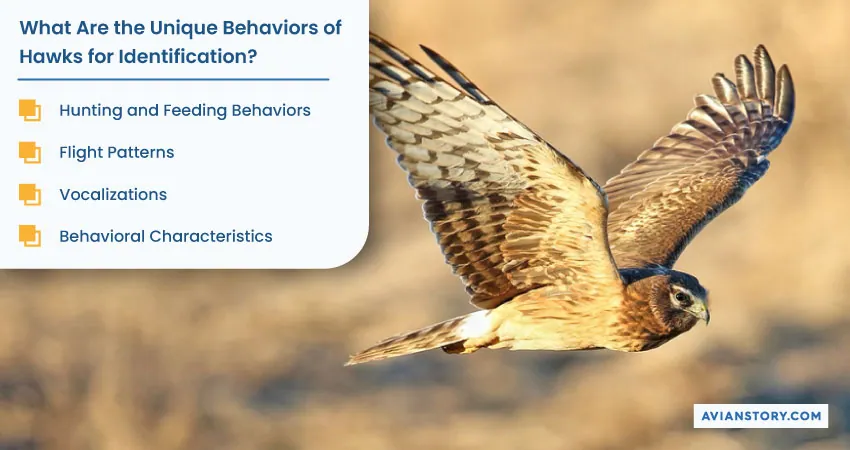
In this section, we describe some unique behaviors of hawks to identify the species.
Hunting and Feeding Behaviors
Hawks are opportunistic predators with a varied diet that primarily consists of small to medium-sized mammals, reptiles, and birds. In particular, their favorite foods are mice, rats, rabbits, sparrows, pigeons, etc.
They use different hunting techniques based on their preferred prey to get food. Some hawks, like the Red-tailed hawks, roam around in the sky over grassland and target small mammals or reptiles to catch.
On the other hand, some hawks, like Cooper’s Hawk, maneuver through forests and catch birds. So, by observing the hunting technique, you can identify a particular breed of hawk.
Flight Patterns
The flight pattern of every hawk is different. So, by critically observing the flight pattern, you will be capable of identifying a particular hawk. For example, Harris’ Hawk forms a distinctive “wing dihedral” or V-shape when soaring.
It is very unique, and most of the other hawks cannot do so. On the other hand, Red-tail hawks fly in broad circles or spirals. It forms a circular slowly while using thermal updrafts to gain altitude.
We also suggest you pay close attention to the wing beat frequency and maneuverability of hawks to differentiate between species.
Vocalizations
To differentiate hawk species, the use of vocalizations required higher experience and expertise. If you are a beginner, you will struggle with this. However, we would like to inform you that hawks use vocalizations to communicate with each other, establish territories, and display courtship behaviors.
Nevertheless, some hawks circulate high-pitched screams or screeches, while others produce whistles, chirps, or guttural calls.
To make you understand more, we would like to provide a Red-tail hawk’s vocalization. This hawk species produces a sound like kee-eeeee-arr while soaring to communicate with each other. In general, this whistling lasts 2-3 seconds.
Behavioral Characteristics
Well, differentiating hawks based on behavioral characteristics is substantially challenging. Like every other similar category of avian, the behavior of hawk species often overlaps.
In terms of behavioral characteristics like territoriality, hunting technique, etc., almost every hawk shows a similar attitude. Still, in terms of migration, you can get some differential contexts.
Though most hawks migrate at the beginning of the winter, there are some differential scenarios. Broad-winged Hawk is a good example; it migrates in the fall and returns to nativity in the spring.
So, we suggest you do not solely depend on behavioral characteristics for the hawk identification process.
How Can Habitat and Location Aid in Hawk Identification?
In the case of habitats, most of the hawks prefer to live near grasslands, deserts, and agricultural areas. However, there are exemptions: Red-tailed Hawks are found in a wide range of habitats, including forests.
The habitat in the forest is quite uncommon. Additionally, migration patterns of hawks also can assist in the identification process. In this case, you have to consider the timing and direction of the migration.
For example, if you see a hawk migrating in late August and September, from north to south, consider this a Swainson’s Hawk.
How Do Hawks Differ in Their Breeding and Nesting Habits?
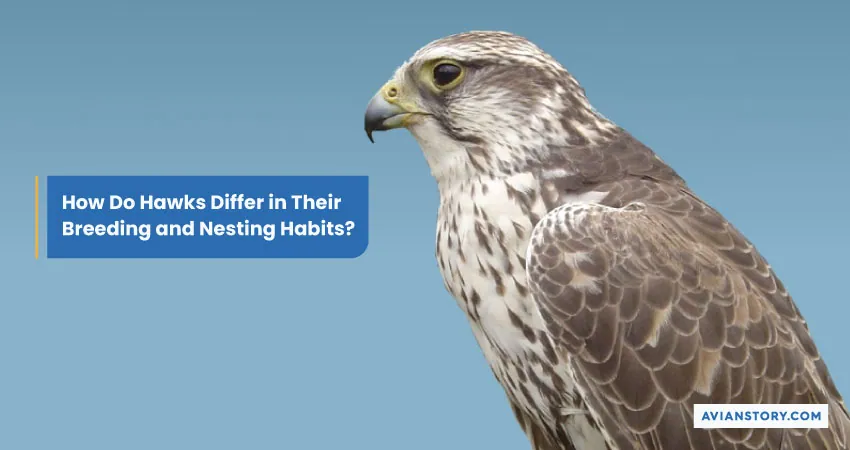
Hawks exhibit variations in their breeding and nesting habits. Nevertheless, you can use these cues for the differentiating process.
Breeding Habits
During the breeding seasons, hawks showcase some particular behaviors that help you to identify a particular type of hawk. These behaviors include the performance of courtship displays, aerial acrobatics, and vocalizations.
Almost every hawk showcases these behaviors during hawk breeding seasons, with some exceptions.
For example, the Red-shouldered Hawk showcases courtship displays by soaring together. At the same time, the Northern Goshawk showcases an extensive amount of territorial displays.
Nesting Habits
Considering hawks, the most common scenario is that each of them builds their nest at a very high level. Here, you have to concentrate on the locations and structures of the nests. We know an exemplary difference can help you understand better.
So, consider this: Broad-winged hawks construct large stick nests in tall trees near bodies of water. In comparison, the Red-tailed Hawks nesting can be found in various locations, including trees, cliffs, or even human-made structures.
How Can Age and Gender Affect Hawk Identification?
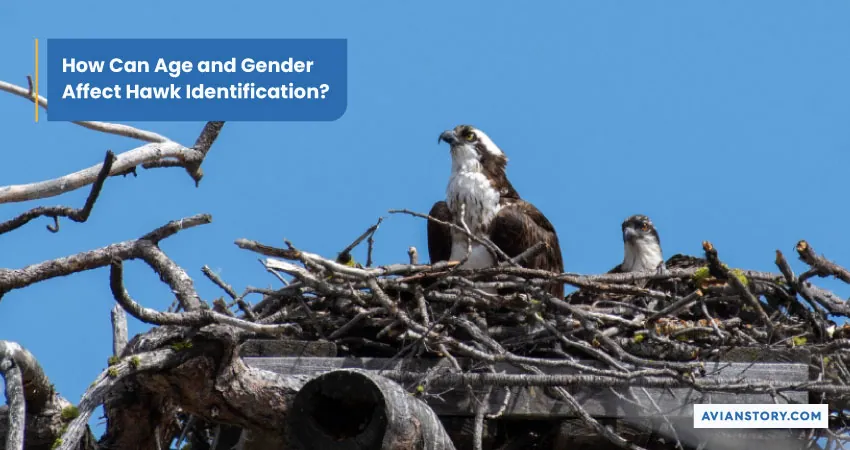
Now check out how age and gender can affect the hawk identification process.
Juvenile vs. Adult Hawks
Juvenile hawks often have distinct plumage patterns and colors compared to adult hawks. The table below shows what you should consider for juvenile vs. adult hawks in the identification process.
However, this differential context is not that helpful in segregating hawk species.
Male vs. Female Hawks
In almost every hawk criterion, females are large in comparison to their counterparts. Also, there are differences in the plumages. For instance, female Red-tailed Hawks are larger than males and usually have darker plumage.
Tools and Equipment Requirement for Hawk Identification
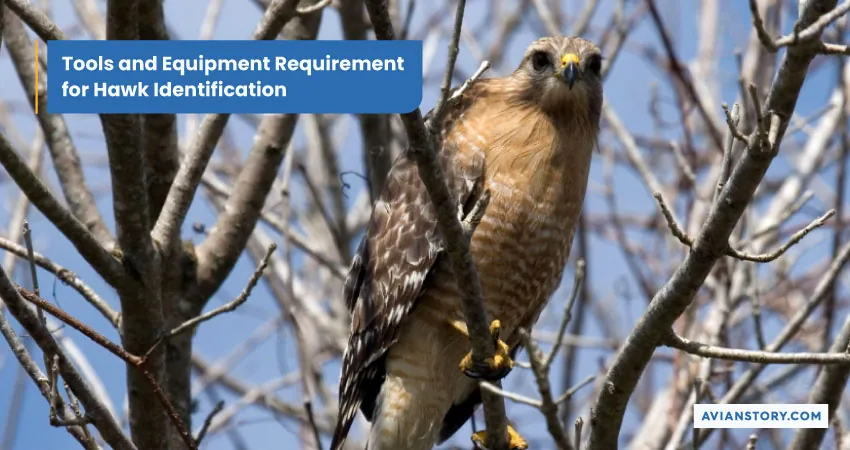
A good pair of binoculars is more than essential to locate and observe their physical characteristics and behaviors. A powerful binocular set allows you to see the details of plumage, markings, etc., without disturbing the bird.
Additionally, using a spotting scope is also beneficial for long-range observations. We highly recommend you carry a notebook and camera to record your observations.
What Are the Major Hawk Species Found Globally?
Now we know how to identify different hawk species. Let’s check the different types of haw species with their unique identification characteristics. Below are the data about the geographical distribution and physical characteristics of common types of hawks on the earth.
1. Ferruginous Hawk (Buteo regalis): It can be found in North America. Ferruginous Hawk is the largest hawk species in the world. The following are its physical characteristics:
- Geographical distribution: North America, Canada
- Habitats: Dry grassland, saltbush, etc.
- Nesting Habit: Netting on long trees, cliffs, etc.
- Plumage color: Bright white underparts and rust-color leg covering
- Length: 22-28 inches
- Breeding behavior: Courtship display, lays 3-4 eggs, and gives parental care to the child.
- Hunting and feeding: Small mammals, birds, snakes, etc. They locate the target from the sky and dive to catch it. Use their talon and beak to get the flesh.
- Flight pattern: Active and slow wing beating.
- Vocalization: Herring Gull’s call (ha-ha-ha-ha-ha)
- Male-female difference: Female are larger
- Wingspan: 51–62 inches
- Beak: Short, dark, hooked beak
- Head: Gray head
- Leg: Feathered
2. Upland Buzzard (Buteo hemilasius): It can be found in Central Asia, Northern South Asia, and East Asia. Below is the info:
- Geographical distribution: China, India, Russia, Bhutan, etc.
- Habitats: Grassland, steppe, the agricultural field, etc.
- Nesting Habit: outcrops, crags, and ledges of cliffs
- Plumage color: Underwings are dark black with pale outer and dark teal feathers
- Length: 25-28 inches
- Breeding behavior: Courtship display, breeds in April and August, and gives parental care to the child.
- Hunting and feeding: Small mammals, birds, snakes, etc. They locate the target from the sky and dive to catch it. Use their talon and beak to get the flesh.
- Flight pattern: Form a “V” shape with the wings
- Vocalization: Nasal mewing for prolonged period
- Male-female difference: Females are larger
- Wingspan: 56–63 inches
- Beak: Black and yellow color with a solid hook
- Head: Yellowish
- Legs: Rough
3. Cooper’s Hawk (Accipiter cooperii): It can be found in North America, Southern Canada, and Mexico. Its characteristics include:
- Geographical distribution: Southern Canada to Northern Mexico
- Habitats: Woodland, wood edges, river grove, etc.
- Nesting Habit: Deciduous, mixed-deciduous, and evergreen forests
- Plumage color: Reddish-barred chest, reddish eye, gray back
- Length: 14–20 inches
- Breeding behavior: Courtship display, breeds once a year, raises one nestling in a year, and gives parental care to the child.
- Hunting and feeding: Small mammals, birds, snakes, etc. They locate the target from the sky and dive to catch it. Use their talon and beak to get the flesh.
- Flight pattern: Flap-flap-glide pattern
- Vocalization: MAke sound “cak-cak-cak” for 2-5 seconds
- Male-female difference: Females are larger
- Wingspan: 30-38 inches
- Bluish-gray back and a reddish-brown barred breast
- Dark gray crown
- Legs and feet are yellow
4. Northern Harrier (Circus cyaneus): It can be found in Europe, Asia, and North America. The below information can help you in the hawk identification process:
- Geographical distribution: Norther USA, Central America, Canada, Mexico
- Habitats: Fields, prairies, etc.
- Nesting Habit: On the ground
- Plumage color: The Underpart is white and the top part is gray
- Length: 18–20 inches
- Breeding behavior: Courtship display, males have multiple partners, and give parental care to the child.
- Hunting and feeding: Small mammals, birds, etc. They locate the target from the sky and dive to catch it. Use their talon and beak to get the flesh.
- Flight pattern: Wings held in a bold dihedral
- Vocalization: Make “kek” notes
- Male-female difference: Females are larger
- Wingspan: 40–45 inches
- Owl-like facial disk
- The short, dark, hooked beak
- Pointed wings
5. Red-shouldered Hawk (Buteo lineatus): Can be found in North America, California, and Central Mexico. Here are its must-mention characteristics:
- Geographical distribution: Eastern North USA, California
- Habitats: Wet forests, etc.
- Nesting Habit: Deciduous or mixed deciduous-coniferous
- Plumage color: Barred underpart, reddish brown feathers
- Length: 19–25 inches
- Breeding behavior: Courtship display, breeds in April and July, and gives parental care to the child.
- Hunting and feeding: Small mammals, birds, insects, etc. They locate the target from the sky and dive to catch it. Use their talon and beak to get the flesh.
- Flight pattern: Accipiter
- Vocalization: Make “kee-ah” sound
- Male-female difference: Females are larger
- Wingspan: 33–50 inches
- Reddish barring on the breast
- Brown head
- Fairly long-tailed
- The short, dark, hooked beak
6. Swainson’s Hawk (Buteo swainsoni): This haw species can be found in Argentina, Paraguay, and some parts of Brazil. The following information will assist you in gaining more knowledge about this hawk species:
- Geographical distribution: Western USA, Canada
- Habitats: Grassland, steeper, savanna, etc.
- Nesting Habit: In trees, on ground
- Plumage color: brown or gray underpart, reddish brown chest
- Length: 18.5–22 inches
- Breeding behavior: Courtship display, breeds in April and March, and gives parental care to the child.
- Hunting and feeding: Small mammals, birds, etc. They locate the target from the sky and dive to catch it. Use their talon and beak to get the flesh.
- Flight pattern: Slightly raised wings, frequent teetering
- Vocalization: Make “kreeeeee” sound
- Male-female difference: Females are larger
- Wingspan: 45-54 inches
- Reddish-brown tail
- Grey/brown head
- Dark belly band
- White throat patch
Final Words
We hope you have a crystal clear idea about the hawk identification process. It is certainly not that easy. Yet, with dedication and patience, you can do it. To identify hawk species, you have to consider physical characteristics, behaviors, habitats, geographic distribution, flight patterns, etc.
Finally, we would like to warn you that each year, a significant number of birders face physical injuries as they eventually forget the respective terrain conditions.
They use binoculars and keep moving; this is very dangerous. So, always be cautious. Check the ground condition before making every step. Lastly, never stop your research on these wonderful creatures.
